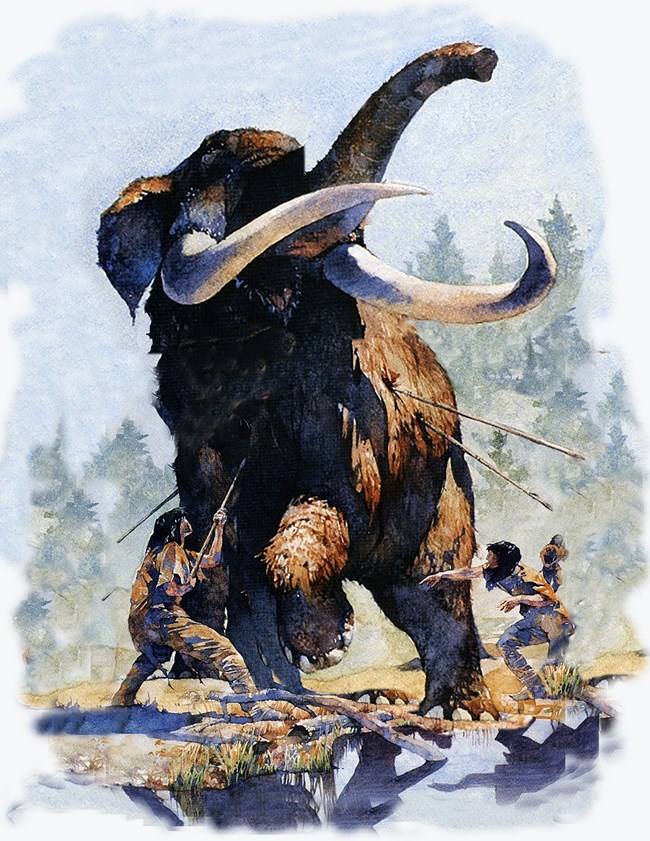
and cultural objects at Great Sand Dunes are protected by federal law. Please leave any artifact you find in place and notify a ranger. NPS Paleo Era
NPS Illustration The newest research suggests that the arrival of the first peoples to North America was much earlier and more complex than previously thought. While the Bering Land Bridge may have been a primary route of entrance from Asia, other routes by boat were likely used as well. The discovery of fossilized human footprints at White Sands National Park dated at 22,000 years BP (Before Present) indicates the first presence of people on the continent significantly earlier than the previous estimates of 13,000 years BP. 
NPS One way to trace early peoples is from distinctive stone projectile points that have survived for millennia. In the 1920s, the discovery of Columbian mammoth remains with long spear points near Clovis, New Mexico was the first documentation of mammoth hunting by people in North America. These early nomadic people began to be referred to as the Clovis culture. With the newest research indicating people here perhaps thousands of years before Clovis, archeologists are now identifying a variety of projectile points associated with Pre-Clovis people. 
Illustration: NPS/Patrick Myers Archeological evidence of Pre-Clovis people at Great Sand Dunes has likely been found, but not yet confirmed as Pre-Clovis. Pre-Clovis projectile points documented from other parts of the continent are quite varied in style, some even resembling points from later eras. The shifting sand environment in many parts of the dunes area does not always maintain stratification representing different millennia, presenting another challenge to positively identifying a Pre-Clovis artifact. Finally, Pre-Clovis research is expanding in North America, but still relatively limited. 
Illustration: NPS/Patrick Myers The atlatl is an ancient tool that uses the laws of physics to achieve far greater velocity in spear throwing by extending the arc of the person's arm. Atlatl darts can achieve speeds over 100 mph (160 kph) with a full-sized atlatl and experienced thrower. Paleo hunters were able to more effectively bring down larger or faster mammals by using this technology. Smaller, thinner, and lighter projectile points such as the Folsom point allowed the dart to travel even farther. 
NPS Illustration At a major Folsom-era archeological site in the national park excavated by the Smithsonian over 15 years, at least 49 bison were trapped into a small dune and killed using atlatls. Four to seven families worked together over about a week, processing the meat to dry, preparing foods, crafting new projectile points, and making clothing and tent covers. Based upon the unique stone source materials in each household, it appeared to be gathering of people from different regions. Margaret (Pegi) Jodry of the Smithsonian supervised the excavation of this important site and captured this research in her thesis, Folsom Technological and Socioeconomic Strategies: Views from Stewart's Cattle Guard and the Upper Rio Grande Basin, Colorado. Archaic Era
NPS Illustration 
NPS At the beginning of the Archaic era around 8,000 – 6,000 years BP, the climate continued to dry and warm, and few Ice Age mammals were left. Projectile points from this era are generally narrower than Paleo points, likely used to hunt smaller mammals such as elk, deer, and modern bison. Bow and arrow technology was introduced late in the Archaic era, around 1,600 years BP, contributing to the need for even lighter points. Pithouses were a common dwelling for many Archaic-era peoples. A circular pit was dug into the soil, then a square or conical structure of timbers was placed over it, covered by animal hides or brush. A small, seasonal version of a pit house was discovered by archeologists west of the dunefield. 
NPS Because projectle points have often been emphasized in archaeological studies, so too have male hunting activities. During the Archaic, a proliferation of ground stone tools provides insight into the gathering and plant processing activities of women and children, including horticulture (and later, agriculture), and the deadfall trapping of small mammals. The social, economic, artistic, and spiritual contributions of all members of society can be viewed among a wider array of material objects. Rare discoveries of ancient toys, artwork, jewelry, and even musical instruments give us glimpses into their creativity, relationships, and spirituality. 
CPR photo For many decades, archeologists were mystified by long, tubular rocks found around the dunes. They are now recognized as ancient musical instruments. Called ‘lithophones’ (litho=rock, phone=instrument), they may have filled the evening air with worship or celebrational music around a campfire. |
Last updated: November 7, 2023
